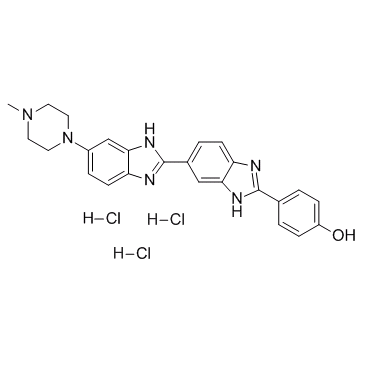Hoechst 33258 (trihydrochloride)

Hoechst 33258 (trihydrochloride) structure
|
Common Name | Hoechst 33258 (trihydrochloride) | ||
|---|---|---|---|---|
| CAS Number | 23491-45-4 | Molecular Weight | 533.880 | |
| Density | N/A | Boiling Point | 643.1ºC at 760mmHg | |
| Molecular Formula | C25H27Cl3N6O | Melting Point | 314 °C | |
| MSDS | Chinese USA | Flash Point | 342.7ºC | |
| Symbol |

GHS07 |
Signal Word | Warning | |
Use of Hoechst 33258 (trihydrochloride)Hoechst 33258 trihydrochloride is a fluorescent dyes, which can be used as a cell dye for DNA. |
| Name | p-[5-(4-methyl-1-piperazinyl)(2,5'-bi-1H-benzimidazol)-2'-yl]phenol trihydrochloride |
|---|---|
| Synonym | More Synonyms |
| Description | Hoechst 33258 trihydrochloride is a fluorescent dyes, which can be used as a cell dye for DNA. |
|---|---|
| Related Catalog | |
| Target |
IC50: 51.31±4.56 μM (HeLa cell), 32.43±3.27 μM (HL60 cell), 15.42±2.16 μM (U937 cell)[1] |
| In Vitro | Hoechst 33258, a fluorescent compound with a head-to-tail bis-benzimidazole structure, is initially found to be cytotoxic against L1210 murine leukemia. Hoechst 33258 is evaluated for their cytotoxicity against human tumor cell lines, which are cervix carcinoma cell line (HeLa), Human promyelocytic leukemia cell (HL60) and U937 cell Line. The IC50 determined in the case of HeLa, HL60 and U937 is 51.31±4.56, 32.43±3.27 and 15.42±2.16 μM for Hoechst 33258, respectively[1]. The cytotoxic property of Hoechst 33258 is investigated on a panel of seven tumour cell lines of different histological origin and Madine-Darby canine kidney (MDCK) normal cells. All cell lines, except MCF-7, exposed to Hoechst 33258 exhibit GI50 from 84×10-6 to 191.5×10-6 mol/dm3. Under the same experimental conditions, Hoechst 33258, used as a binder reference compound, stops the cell cycle in S phase and G0/G1[2]. |
| Cell Assay | Hoechst 33258 is prepared as stock solutions in highly pure water. Working solutions in a concentration range of 10-3-10-6 mol/dm3 are prepared prior to testing. Cytotoxic effects of Hoechst 33258 on tested cell lines are determined by the MTT assay. Cells are seeded in 96 micro well flat bottom plates at a concentration of 2×104 cells/mL and left overnight in the CO2 incubator allowing them to attach to the plate surface. Growing medium is replaced with compound supplemented or control medium and incubated for 72 h. Fresh medium with 5 mg/mL of MTT is added onto cells and incubated for 4 h at 37°C. Upon media removal, water insoluble MTT-formazan crystals formed inside the living cells are dissolved in DMSO and the absorbance at 570 nm proportional to the number of living cells is measured on an Elisa Microplate Reader. All experiments are performed at least three times in triplicates.The GI50 value, defined as the compound concentration (μM) leading to cellular growth inhibition by 50%, is calculated and used as a parameter to compare cytotoxicity among the compounds[2]. |
| References |
| Boiling Point | 643.1ºC at 760mmHg |
|---|---|
| Melting Point | 314 °C |
| Molecular Formula | C25H27Cl3N6O |
| Molecular Weight | 533.880 |
| Flash Point | 342.7ºC |
| Exact Mass | 532.131165 |
| PSA | 84.07000 |
| LogP | 6.63950 |
| Storage condition | 2-8°C |
| Water Solubility | SOLUBLE |
CHEMICAL IDENTIFICATION
HEALTH HAZARD DATAACUTE TOXICITY DATA
MUTATION DATA
|
| Symbol |

GHS07 |
|---|---|
| Signal Word | Warning |
| Hazard Statements | H302-H315-H319 |
| Precautionary Statements | P305 + P351 + P338 |
| Personal Protective Equipment | dust mask type N95 (US);Eyeshields;Gloves |
| Hazard Codes | Xn: Harmful; |
| Risk Phrases | R22 |
| Safety Phrases | S26-S36-S24/25-S23 |
| RIDADR | NONH for all modes of transport |
| WGK Germany | 3 |
| RTECS | SM1140500 |
|
Early life exposure to chronic intermittent hypoxia causes upper airway dilator muscle weakness, which persists into young adulthood.
Exp. Physiol. 100 , 947-66, (2015) What is the central question of this study? Chronic intermittent hypoxia (CIH) is a dominant feature of respiratory control disorders, which are common. We sought to examine the effects of exposure to... |
|
|
Synoviocyte Derived-Extracellular Matrix Enhances Human Articular Chondrocyte Proliferation and Maintains Re-Differentiation Capacity at Both Low and Atmospheric Oxygen Tensions.
PLoS ONE 10(6) , e0129961, (2015) Current tissue engineering methods are insufficient for total joint resurfacing, and chondrocytes undergo de-differentiation when expanded on tissue culture plastic. De-differentiated chondrocytes sho... |
|
|
Drosophila Gyf/GRB10 interacting GYF protein is an autophagy regulator that controls neuron and muscle homeostasis.
Autophagy 11 , 1358-72, (2015) Autophagy is an essential process for eliminating ubiquitinated protein aggregates and dysfunctional organelles. Defective autophagy is associated with various degenerative diseases such as Parkinson ... |
| BBIH |
| BISBENZIMIDE H 33258 |
| Hoechst33258 |
| Hoechst Stain |
| 4-[5-(4-Methylpiperazin-1-yl)-1H,1'H-2,5'-bibenzimidazol-2'-yl]phenol trihydrochloride |
| BISBENZIMIDE |
| Phenol, 4-[5-(4-methyl-1-piperazinyl)[2,5'-bi-1H-benzimidazol]-2'-yl]-, trihydrochloride |
| Bisbenzimide H 33258 trihydrochloride |
| 2'-(4-Hydroxyphenyl)-5-(4-methyl-1-piperazinyl)-2,5'-bi-1H-benzimidazole Trihydrochloride |
| Phenol, 4-[5- (4-methyl-1-piperazinyl)(2,5'-bi-1H-benzimidazol)- 2'-yl]-, trihydrochloride |
| Bisbenzimide H 33258 Hydrate |
| MFCD00012679 |
| 4-[5-(4-Methyl-1-piperazinyl)-1H,1'H-2,5'-bibenzimidazol-2'-yl]phenol trihydrochloride |
| Hoechst 33258 |
| 2'-(4-hydroxyphenyl)-5-(4-methylpiperazin-4-ium-1-yl)-3H,3'H-2,6'-bi-3,1-benzimidazol-1-ium trichloride |
| Phenol, p-[5-[5- (4-methyl-1-piperazinyl)-2-benzimidazolyl]-2- benzimidazolyl]-, trihydrochloride |
| Pibenzimol HCl |
| Phenol, 4-(5-(4-methyl-1-piperazinyl)(2,5'-bi-1H-benzimidazol)-2'-yl)-, trihydrochloride |
| phenol, 4-[6-(4-methyl-1-piperazinyl)[2,5'-bi-1H-benzimidazol]-2'-yl]-, hydrochloride (1:3) |
| phenol, 4-[5-(4-methyl-1-piperazinyl)[2,6'-bi-1H-benzimidazol]-2'-yl]-, hydrochloride (1:3) |
| EINECS 245-690-6 |
| Phenol, 4-[5-(4-methyl-1-piperazinyl)[2,5'-bi-1H-benzimidazol]-2'-yl]-, hydrochloride (1:3) |
| Hoechst 33258 (trihydrochloride) |

